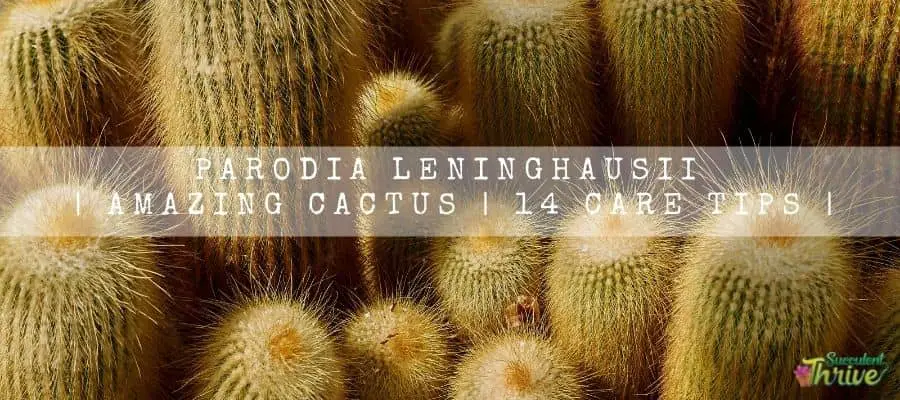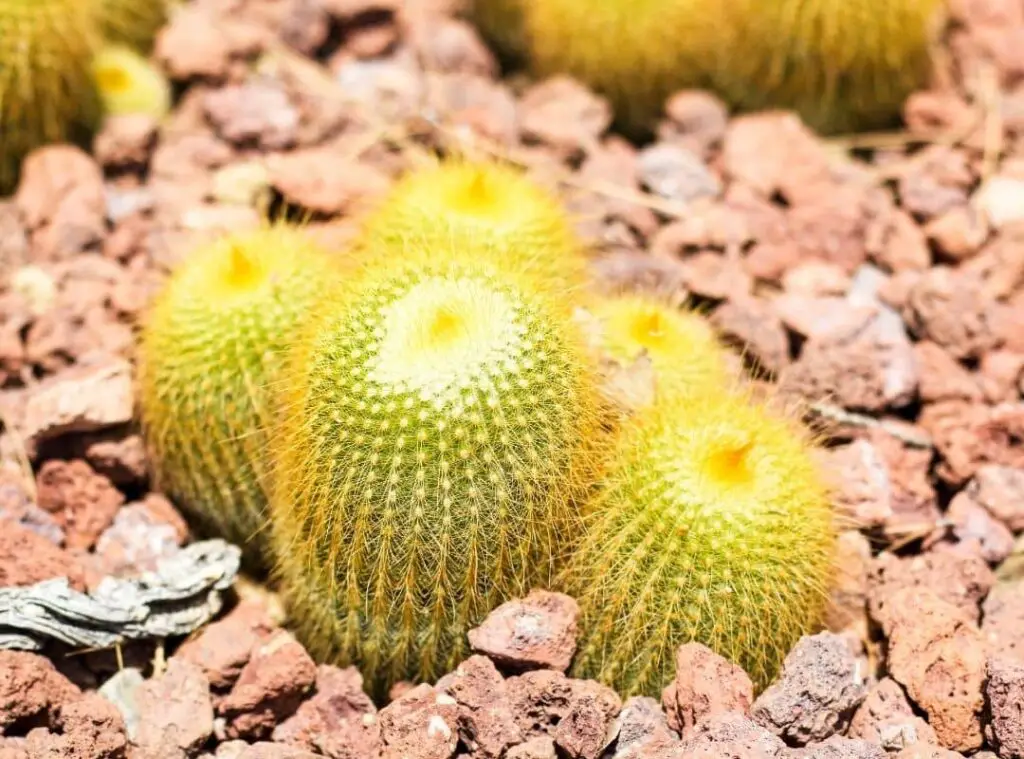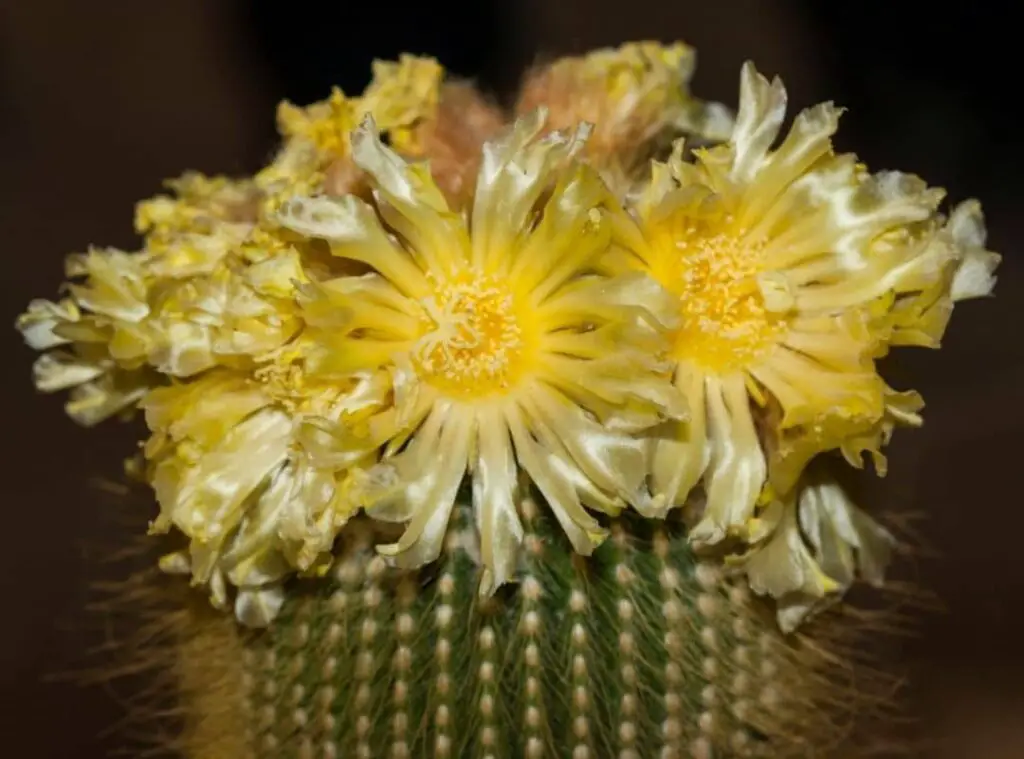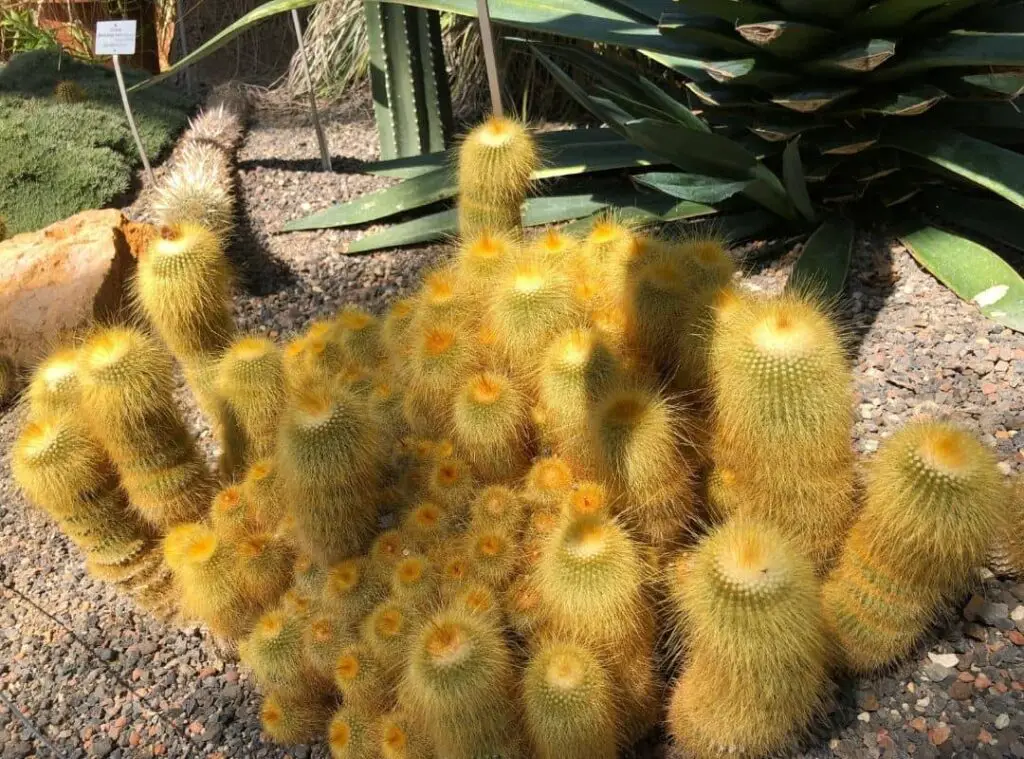Parodia leninghausii is a perennial cactus and people call them other names such as Lemon ball cactus, yellow tower cactus and Golden ball cactus.
These are endemic plants in Brazil and in Paraguay. You could commonly find them in hilly grasslands where they tend to grow under giant plants. They are tolerant of a wide range of temperatures as well.

More About Parodia leninghausii.
Golden ball cactus, as you may understand from its name itself, tend to look like a golden globe. Having said that, they could grow taller as they mature and get older.
When they grow older, they would grow in tall columns which would completely look different to their look when they are young.
Having said that, cactus in general grow slowly. In addition to that, if you grow them in small pots, they will remain compact forever.
Parodia leninghausii inherited their name from a cactus collector called Wilhelm Lenninghaus who is originally from Germany, but he left for Brazil in the 1880s.
These are soft cactus, and you could easily handle them when comparing them with the rest of other spiny cacti.
So, if you are excited to have this cactus in your garden, you may continue reading this article and enhance your knowledge on how to take care of them well.
How do I identify parodia leninghausii?
Parodia leninghausii comprises yellow spines. They are long and gentle and resemble a look of golden hair.
That gives them a look of a gold glowing aura too. They are globular shaped and later they would tend to take a columnar shape.
Further these are quite soft succulents. As aforesaid, they tend to look like golden balls when they are young. However, when they grow older, they could grow tall columns.
Parodia leninghausii would consist of 30 ribs. Further they would grow in clusters.
When Golden ball cactus get taller (8 inches in height) they would start producing flowers in bright yellow during spring and in summer.
They would usually arise at the top of the plants. Those flowers would be about 2 inches in width.
What is more special about these plants is that Parodia leninghausii spines are harmless. The foliage color would be green, and the yellow spines would be visible on the white areolas.
Not only that but also, golden ball cactus produces globose fruits as well.
Size of the plant
Parodia leninghausii would rise to 3 feet in height. On the other hand, their maximum radius would be 5 inches.
Growth rate
Parodia leninghausii are slow growing plants.
If you have grown them in small pots, they will remain small. Further if you have grown them in somewhat larger pots, they could get taller and grow.
One look care guide
| Botanical Name | Parodia leninghausii |
| Common Name | Golden ball cactus Lemon ball cactus, yellow tower cactus |
| Plant Type | Cactus |
| Mature Size | 3 feet in height / 5 inches in radius |
| Sun Exposure | Full sunlight to partial sunlight |
| Soil Type | Sandy, well-draining |
| Soil pH | pH Range: 6.5 to 8.5 |
| Bloom Time | mid-summer to late summer. |
| Flower Color | Yellow Bloom |
| Hardiness Zones | USDA hardiness Zone 10 (30F). |
| Native Area | Brazil, Paraguay |
| Toxicity | Non toxic |
| Average price | $ 3 |
How do you take care of Parodia leninghausii?
Light Requirement
Parodia leninghausii could thrive well if they are given full sunlight for about 6 hours per day daily. Ideally you need to leave them somewhere shady during the afternoon hours.
Avoid exposing Golden ball cactus to direct sunlight during intense summer conditions. Parodia leninghausii could withstand the direct sunlight during morning hours and in the late afternoon.
As such if you are growing them outdoors, you should select a place where they can gain sufficient sunlight levels, ideally in a place where they can get not too intense sunlight during afternoon hours.
Further when you grow them as houseplants, you need to place them near a bright sunny windowsill at your home.
If you think the sunlight levels are still inadequate, you should consider growing them near grow lights.

Temperature and humidity
Parodia leninghausii cannot withstand temperatures below 7 degrees Celsius.
They are not cold hardy plants, and it is very unlikely that they can survive in such conditions.
As such if any frost condition is predicted, you need to immediately shift them indoors.
Is it cold hardy?
Parodia leninghausii are not cold hardy plants.
USDA Hardiness Zone
These succulents are hardy in USDA hardiness Zone 10 (30F).
Watering Requirement
Watering the Parodia leninghausii properly is very crucial when you take care of them well. If you water them properly, that will allow the plants to grow vigorously and healthily.
Ideally you need to water them during spring and in summer right throughout so that you could keep the soil lightly moist.
On the other hand, you could cease watering them or do it only if you could see any sign of under watering.
As usual keep in mind that you need to allow the soil to become dry between two watering sessions. Having said that, you should be vigilant to not leave the soil bone dry.
If you end up under watering them, roots will dry, and it could attribute the plants to wilt.
On the other hand, if you supply them with an abundance of water on a frequent basis, that would make these cacti more prone towards diseases such as root rot.
Further you need to adjust your watering pattern depending on the plant’s age, lighting conditions, soil type and on the container size as well.
You could follow the below tips when watering these cacti,
- When watering them, water them well and thoroughly. Further check whether the excess water is moving out from the pot’s draining holes.
- Do not use cold water as it could traumatize the cactus.
- As you may already know, it is vital that these cacti have enough oxygen levels so that they can thrive well. Avoid leaving them in a saucer filled with water as the high humidity levels could be so attractive for bacterial and for fungal infections.
Soil Requirement Type / pH
Soil pH of 6.5-8.5 would be helpful for an optimal growth of these plants. Parodia leninghausii would prefer to grow in a mostly sandy soil mix.
It is vital that you grow them in a rich fast draining soil mix as that would be quite helpful for these cacti to grow healthily as well as vigorously.
You could use a blend of sand, chalk, and loam to grow them, and it would be a perfect mix for their survival.
Alternatively, you could grow them in a succulent soil mix or in a cactus soil mix.
Flowering and Fragrance
Parodia leninghausii produces blooms in yellow. Further their flowering season would be in mid-summer to late summer.
Their flowers are showy, and it will be so fascinating to watch them flowering. It will be an added advantage to have them in your house.

Pot size Potting and Repotting
If you go ahead with a pot which is smaller for prolonged periods, that could make these plants root bound and halt any further growing.
As such best is to grow them in a pot which is about 1 inch bigger than the cactus diameter.
When it comes to the repotting of the plants, you may do it periodically ideally in warmer seasons.
However, before you proceed you need to check whether the soil is dry and only then start the proceedings.
First remove the plant from the pot without injuring it. you could get rid of the old soil from the plants. Furthermore, you need to snip off any rotten or damaged roots if you find any.
You may apply fungicides to treat those cuts. Once you complete that, you could plant them in a new pot filled with a fresh soil mix which has excellent drainage.
When you plant them ensure that you provide it with adequate space so that the roots could spread as they grow.
Skip watering them for about one week’s time and only then start watering them lightly. That will minimize the potential of having any root rot. Do not apply any fertilizers so that it will help the roots to acclimate.
Where to Plant
You could plant them indoors or outdoors. Having said that, you need to make sure that it could gain adequate sunlight levels no matter where you grow them.
It could possibly be a bright sunny windowsill if you grow them indoors.
Further if you have grown them outdoors, you need to bring them indoors to protect them from frost conditions as they are not cold hardy.
Fertilizer and time of year
When it comes to fertilizing these plants, you could go ahead with a diluted quick release fertilizer, or a temperature controlled slow-release fertilizer.
You could use organic fertilizers or inorganic fertilizers depending on your wish. For example, you could use fish emulsion etc. You should skip feeding them when they are dormant in winter.

Dormancy
They would go dormant in winter.
Can be toxic to pets
There are no reports of Parodia leninghausii toxicity.
Common bugs and illnesses
Parodia leninghausii is usually resistant to pests’ attacks. Having said that, mealybugs and several other pests could invade these plants.
You could spot the mealybugs as little white cotton substances soft bodies. Further they consist of a waxy powdery layer as well.
They could be so annoying since they could suck the sap of these plants. You could spot them forming in colonies.
Once your cactus invades by these cacti, it could lead the plant for yellowing and for leaf drop as well.
They produce a sweet substance and that would result in further fungal infections such as Sooty mold. To remedy them you need to immediately quarantine these plants from the rest as it could spread faster.
You could further treat them with a chemical treatment or introduce lady beetles which could help to overcome these pests naturally by reducing them.
Apart from mealybugs, they could be infected with aphids as well. They are yet another tiny set of creatures which tend to move slowly.
Aphids also tend to feed on the Golden ball cactus sap. You could find aphids forming in numerous colors.
They could be so irritating as they could multiply faster. Aphids could be quite visible particularly during spring and in Autumn.
To remedy the Aphids attacks, you need to wash the damaged parts or treat them with chemical products or with inorganic elements.
In addition to these, root rot is another major concern which these cacti would come across. Over-watering could mainly affect this condition. You need to practice the aforesaid tips when watering them.
Special Care tips
Golden ball cactus can thrive well on their own and it is not necessary to do any grooming or any maintenance.
However, keep in mind that you need to avoid over watering which could result in root rot. On the other hand, protect these plants from extreme winter conditions as well.
How to propagate Parodia leninghausii
There are a couple of ways of propagating these cacti. They are by using seeds and offsets.
If you wish to use the seeds to propagate the Golden ball cactus, you need to keep the seedlings moist during the first few months. After that you need to wait patiently until they start growing.
Secondly if you wish to use the offsets to propagate the Golden ball cactus, you could take off the offsets from the base of the plant carefully.
After that you could leave them in a dry and a warmer place so that they can wither and develop callous.
When they become callous, you could plant them in a fresh soil mix. Next you may leave them somewhere so that they can form new roots.
When you spot them forming roots, you could replant them in an ordinary pot so that they can grow normally.
Conclusion
As you may realize, it is very easy to take care of the Golden ball cactus.
You only need to make sure that you do not supply them with excess water and expose them to strong sunlight levels during daytime.
Apart from that keep in mind that you need to plant them in a porous soil mix which has excellent drainage. If you manage to fulfil these necessities, they will flourish and thrive well.
Read Next Rat Tail Cactus Propagation | 2 Effective Methods For You | Rat Tail Cactus Aerial Roots | 4 Forgotten Facts For You | Crested Rat Tail Cactus | 9 Effective Ways To Take Care Of Them |
